Hands-on with the GeForce RTX 2080 Ti: Real-time Raytracing in Games
by Nate Oh on August 21, 2018 5:30 PM EST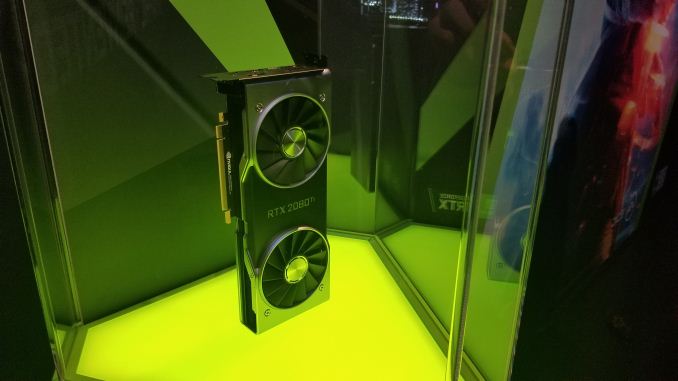
After yesterday’s announcement from NVIDIA, we finally know what’s coming: the GeForce RTX 2080 Ti, GeForce RTX 2080, and GeForce RTX 2070. So naturally, after the keynote in the Palladium venue, NVIDIA provided hands-on demos and gameplay as the main event of their public GeForce Gaming Celebration. The demos in question were all powered by the $1200 GeForce RTX 2080 Ti Founders Edition, with obligatory custom watercooling rigs showing off their new gaming flagship.
While also having a presence at Gamescom 2018, this is their main fare for showcasing the new GeForce RTX cards. In a separate walled-off area, NVIDIA offered press some gameplay time with two GeForce RTX supporting titles: Shadow of the Tomb Raider and Battlefield V. Otherwise, they also had a veritable army of RTX 2080 Ti equipped gaming PCs for the public, also demoing Battlefield V and Shadow of the Tomb Raider (without RTX features), along with Hitman 2 and Metro: Exodus. Additionally, there were a few driving simulator rigs for Assetto Corsa Competizione, including one with hydraulic feedback. These games, and more, support real-time ray tracing with RTX, but not necessarily Deep Learning Super Sampling (DLSS), another technology that NVIDIA announced.
| NVIDIA RTX Support for Games As of August 20, 2018 |
||||
| Game | Real-Time Raytracing | Deep Learning Super Sampling (DLSS) | ||
| Ark: Survival Evolved | No | Yes | ||
| Assetto Corsa Competizione | Yes | No | ||
| Atomic Heart | Yes | |||
| Battlefield V | Yes | No | ||
| Control | Yes | No | ||
| Dauntless | No | Yes | ||
| Enlisted | Yes | No | ||
| Final Fantasy XV | No | Yes | ||
| Fractured Lands | No | Yes | ||
| Hitman 2 | No | Yes | ||
| Islands of Nyne | No | Yes | ||
| Justice | Yes | |||
| JX3 | Yes | |||
| MechWarrior 5: Mercenaries | Yes | |||
| Metro Exodus | Yes | No | ||
| PlayerUnknown's Battlegrounds | No | Yes | ||
| ProjectDH | Yes | No | ||
| Remnant: From the Ashes | No | Yes | ||
| Serious Sam 4: Planet Badass | No | Yes | ||
| Shadow of the Tomb Raider | Yes | No | ||
| The Forge Arena | No | Yes | ||
| We Happy Few | No | Yes | ||
GeForce RTX 2080 Ti Hands-on: Shadow of the Tomb Raider
Starting with Shadow of the Tomb Raider, I got to play through a platforming puzzling sequence that was amusingly difficult to navigate. I thought I was just bad, but the neighboring gamer fared just as poorly and we ended up trading tips on each successive obstacle. Poor skills aside, the game was rendered in 1080p and capped at 60fps with the graphics settings locked, but I could definitely notice framedrops, even though the gameplay was rather slow-paced.
The game was rendering an outdoors scene, but because of the 1080p quality on a roughly 24” screen, I couldn’t see much of an overall quality improvement. Unfortunately, I didn’t realize until afterward that we had the option of capturing our footage, though honestly I’m glad no one was subjected to a video recording of my gaming incompetence.
Because we only had a certain allotted time, we didn’t get to finish that puzzle sequence, but from a real-time ray tracing perspective, it was hard for me to distinguish any added effects. It appears that this opinion was similar enough to others’ that the Tomb Raider Twitter issued a clarification.
GeForce RTX 2080 Ti Hands-on: Battlefield V
For Battlefield V, the situation was similar with a 1080p 144Hz monitor, playing on the Rotterdam map over LAN. There were framedrops during fast-paced scenes and in general it didn’t seem like it could keep up with the game. Again, there was no FPS info available but the RTX 2080 Ti was almost surely not cranking out constant 60fps. Here, the real-time ray tracing was quite noticeable, with vivid dynamic reflections in puddles, windows, and river. Even at 1080p, those features added to the overall image quality, though the ultimate performance cost was unclear. Framerates aren't a good tradeoff for image quality in fast-paced FPS', though for the record, I’ve always been terrible at shooters (except maybe Halo 2).
While the in-game real-time ray traced footage trailer is obviously putting the game and RTX in the best light possible, there is visible merit in explosions and lighting being reflected where they should. This time around, recorded gameplay footage could not be published until a later date, so words are all we have.
Assetto Corsa Competizione, Custom Models, and GeForce RTX 2080 Ti Photo Ops

Venue-goers try out the racecar rig after my turn is up
I also tried out Assetto Corsa Competizione on the rig with hydraulic suspension feedback, the whole setup being apparently worth over 40,000 euros. Only to find out what I already knew: I can’t drive a racecar (or non-automatics). The game is less intensive than Battlefield V or Shadow of the Tomb Raider, and on that note I didn’t notice any framedrops as I was half-racing half-crashing around the track.
In Gamescom proper, there were a few GeForce RTX 20-series AIB cards on display, including EVGA and Palit/Gainward. The Palit/Gainward representative mentioned their custom cards would be due mid-September, and that they had yet to start shipping, an interesting but unsurprising tidbit considering NVIDIA had just announced a firm date.
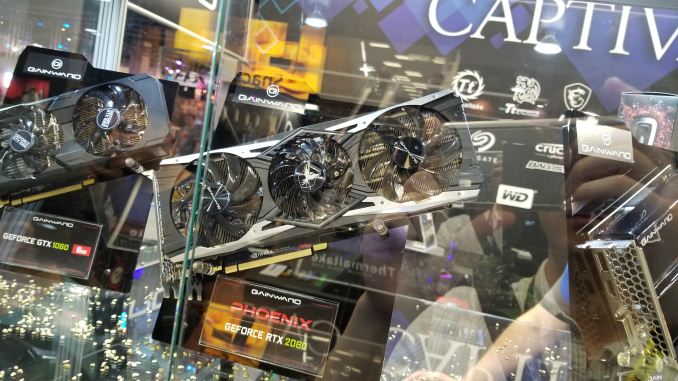
With real-time raytracing, games will be able to recreate realistic reflections as seen in bad photos like this one...
NVIDIA even had a Gamescom booth with just the GeForce RTX 2080 Ti in a glass display stand, meant for photo ops. People got an NVIDIA RTX T-shirt out of it but it was somewhat amusing to see people line up to take a picture with a graphics card in the middle of a million public gaming demos.
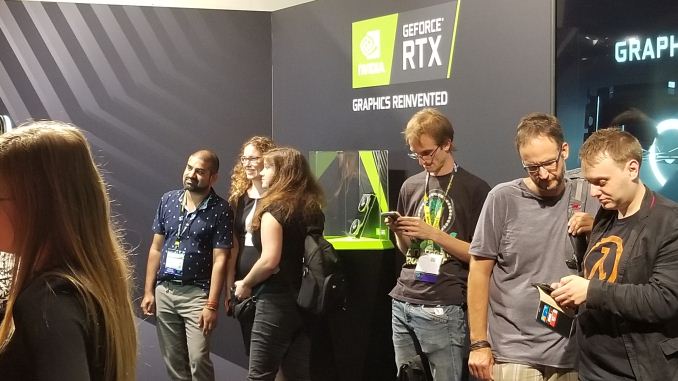
Somehow, I think it would've been more 'normal' to see people take selfies with a graphics card
In any case, I think there are a few relevant takeaways from the hands-on:
- RTX in terms of real-time ray-tracing is still in development, which is something confirmed by developers themselves for Shadow of the Tomb Raider and Battlefield V;
- As presented thus far, RTX in terms of both real-time ray-tracing and deep learning super sampling (DLSS) require developer support and implementations may vary between them;
- As presented thus far, RTX in terms of a technology or a platform is fairly confusing for gamers, because includes a few different technologies like real-time ray-tracing and deep learning super sampling (DLSS), but also provides the namesake for the “GeForce RTX” 20-series and “GeForce RTX” branded games (we will explain all this in detail when the time comes);
- The demos didn’t clarify apples-to-apples performance differences between the GTX 1080 Ti and RTX 2080 Ti
- September 20 is a long time to go without third-party objective analysis


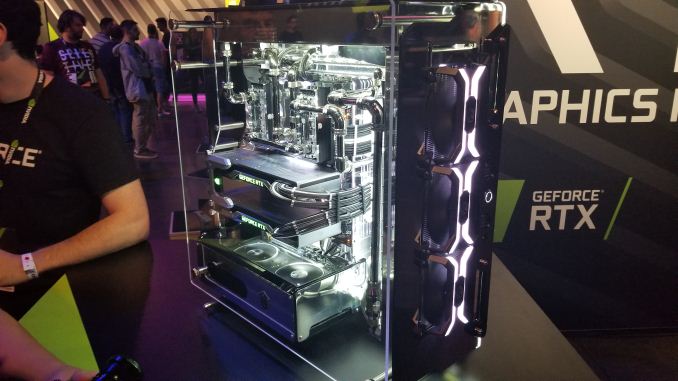

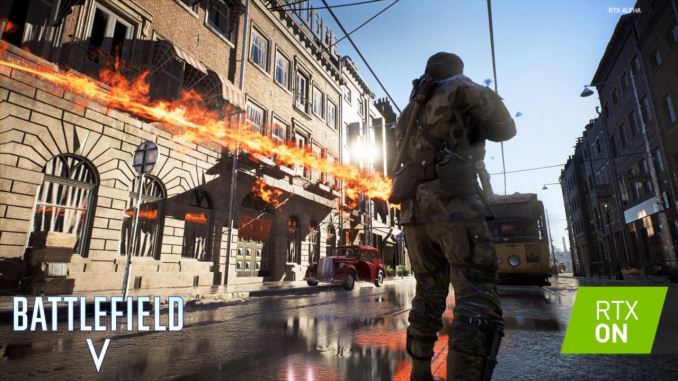



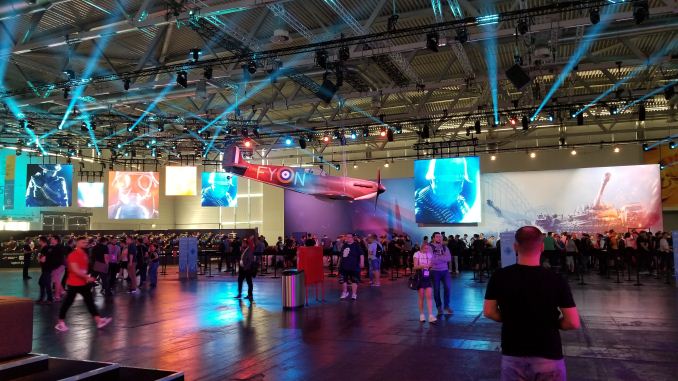








103 Comments
View All Comments
xXx][Zenith - Tuesday, August 21, 2018 - link
So my take DXR/RTX confusion: DXR is ray tracing API, an extension to MS DX12 with full interop with raster pipeline. MS will support DXR with a compute shader fallback layer, so devs can ship DXR effects to all DX12 class gpus. RTX is an implementation of the DXR API by NVIDIA (with dedicated HW elements in the ASIC). RTX is only supported on Volta and Turing, Pascal has to live wih the fallback path. AMD made no annoucment about their level of support regarding DXR.A quick perf video with MS Github DXR samples featuring Pascal: https://youtu.be/2kW3Rs4V6FA
Alexvrb - Tuesday, August 21, 2018 - link
Well even with the latest RTX card it sounds like realtime ray tracing is still knocking performance down substantially. Cherry picked 1080p demos that aren't smooth, ouch. Then you've got yet-another-propietary-supersampling method from Nvidia. I guess they had to figure out something to do with the AI block for their gaming cards, rather than let it sit dormant. Let's hope this SS method doesn't damage image quality.With that being said the overall performance gains are still rumored to be substantial, if you're not turning on the new eyecandy. Best of all the 2070 will spur price drops on the older tech, even if the 2080 models are frickin' expensive as heck.
lucam - Wednesday, August 22, 2018 - link
PowerVR has a much better and performance solution if you bring everything to right scale. No mobile solution can't even be any closer to what Imagination has developed by far. And yet we are still debating about NV solution that in RT is really mediocre solution considering the horsepower it has. Not efficient solution at all...jabber - Wednesday, August 22, 2018 - link
Yep, tile rendering for the win!edzieba - Wednesday, August 22, 2018 - link
Nvidia have been using tiled rendering since Maxwell.Samus - Wednesday, August 22, 2018 - link
Tile rendering has nothing to do with ray tracing. The ray tracing calculations/arithmetic are what is slowing things down. The rendering differential to include ray tracing calculations is negligible, and sure, tiled viewpoint rendering would assist that performance like it would assist any sort of viewport rendering. But the calculations happen before the rendering.silverblue - Friday, August 24, 2018 - link
Exactly; work out what you don't need to draw before you draw it.piiman - Saturday, August 25, 2018 - link
They already do this, if you had listened to the Key Noteiwod - Wednesday, August 22, 2018 - link
I would actually like a write up on the difference between PowerVR RT and NV RT.lucam - Wednesday, August 22, 2018 - link
This is a good idea actually...